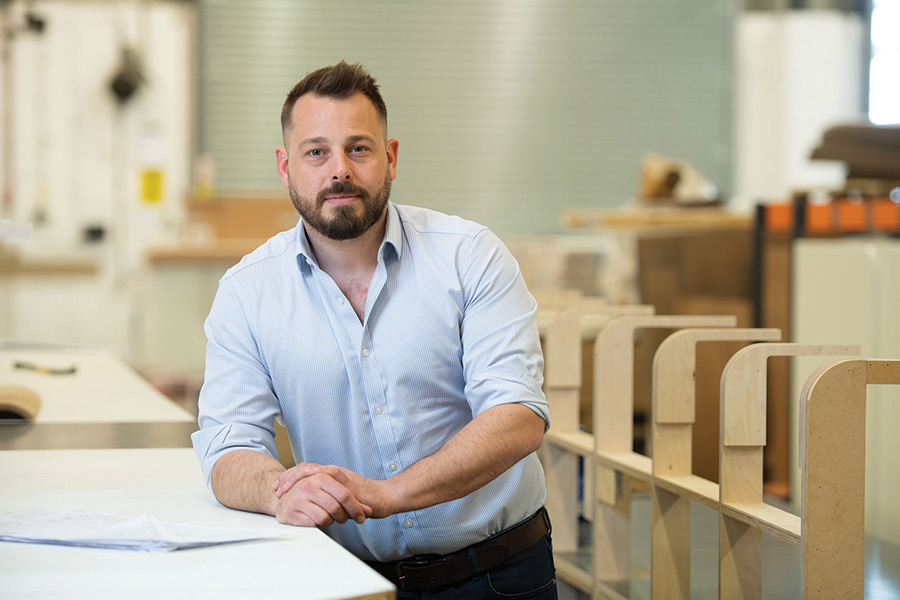By Matt Cater, Owner of Fathom Displays
In flooring retail, no two stores are the same. They vary wildly in footprint, layout and priorities, which can be a real headache for brands trying to scale their presence across independent retailers. You want to deliver a recognisable and consistent, high-impact experience without spiralling costs or logistical complexity. That’s where modularity comes in. Not as a design trend, but as a practical solution to a very real operational challenge.
Modularity means building systems that work across these different spaces, with components that can be repeated, reconfigured and reused – whether you’re working with a small showroom or a large retail outlet. Sometimes that means bolting together identical modules to create scale. Other times, it’s a starter unit with add-ons that extend indefinitely. Either way, the principle is the same: design once, adapt everywhere.
Efficiency that scales
A modular approach allows you to tailor the display to each site without reinventing the wheel. You’re not designing bespoke fixtures for every store. You’re configuring a shared system to suit different needs. It’s smart, efficient, and from a manufacturing point of view, economically sound. Standardising components drives down cost, simplifies stock handling and reduces logistical friction.
If you’re making the same thing repeatedly, you’re not juggling dozens of SKUs, and you’re building in consistency that pays off across the rollout. When installation teams are working with familiar parts, it builds tacit knowledge. Installers know how the system fits together. They’re not second-guessing layouts or hunting for obscure fixings, which speeds things up, lowers the risk of error and makes the whole process more manageable.
It also brings clarity and sustainability to the supply chain. Reducing the number of unique parts means less waste, leaner inventory and more predictable shipping. You’re not over-ordering items that might never be used again. You’re building a system that’s easier to pack, quicker to move and straightforward to install – which keeps momentum high and headaches low.
Designing for real-world use
But modularity isn’t just about repeatability. It’s about adaptability and functionality. A well-designed modular display should serve multiple roles without multiplying components. Take an end unit, for example. If you can design it to work as both a left-hand and a right-hand component, you’ve immediately halved your SKU count, which is exactly what we did in our POPAI award-winning display for Karndean Designflooring.
Instead of managing hundreds of left- and right-handed units, they ordered a single universal component. That one decision took pressure off planning teams and removed the guesswork from rollout projections. Installers didn’t have to worry about which side they were building – they just got on with it. It was a small design decision that made a big operational impact and allowed for flexibility without adding complexity.
In designing in this way, we look not only at the module itself but also how it’s designed to behave. Can it be packed efficiently? Can it be shipped without excess cost? Can it be installed without specialist tools? Can it be stored or de-installed without damage? These are the questions we ask at the start of every project – not just what the display needs to do, but how it needs to live. From manufacture to end-of-life, every stage matters.
Modularity that makes sense
This is why we put so much energy into qualifying the brief. Modularity isn’t always the answer, and it only works if it’s grounded in reality. Sometimes brands build in flexibility they’ll never use. Other times, they don’t build in enough and end up stuck when the range evolves or the store layout changes. This is why we challenge everything from the get-go, asking the right questions to determine whether modularity is the right route.
When a client says they want interchangeable graphics, for example, we ask how often they’ll change them. If it’s once every three years, maybe double-sided tape is enough. It’s about balancing what’s nice to have with what’s actually going to be used. Because every added feature comes with a cost, and if it’s not going to be used, it’s just noise.
This approach also allows for futureproofing. What might this display need to do in six months? Can we build in scope now, without adding unnecessary complexity? Sometimes it’s as simple as adding a couple of redundant holes or allowing for a bracket that might be used later. The aim is to squeeze every drop of efficiency and longevity out of a display unit – whether that means designing with modularity or not.
Ultimately, modularity is about control. It gives brands the ability to scale without losing their identity. It gives retailers the freedom to adapt without compromising the look and feel of the brand. And it gives operations teams a way to roll out displays that are consistent, efficient and built to last. What starts as a solution to logistical complexity becomes a system that delivers, again and again.

